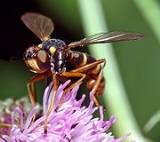
Conopidae
Encyclopedia
Conopidae, usually known as the thick-headed flies, is a family of flies
within the Brachycera
suborder of Diptera
. Flies of the family Conopidae are distributed worldwide except for the poles and many of the Pacific islands. About 800 species in 47 genera are described worldwide, approximately 70 of which are found in North America. The majority of conopids are black and yellow, or black and white, and often strikingly resemble wasps, bees, or flies of the family Syrphidae, themselves notable bee mimic
s. Conopids are most frequently found at flowers, feeding on nectar with their proboscis
, which is often long.
The larvae of all conopids are internal parasites, most of aculeate (stinging) Hymenoptera
. Adult females aggressively intercept their hosts in-flight to deposit eggs. The female's abdomen is modified to form what amounts to a "can opener" to pry open the segments of the host's abdomen as the egg is inserted. The subfamily Stylogastrinae, including the genus Stylogaster
, is somewhat different, in that the egg itself is shaped somewhat like a harpoon
, with a rigid barbed tip, and the egg is forcibly jabbed into the host. Some species of Stylogaster are obligate associates of army ant
s, using the ants' raiding columns to flush out their prey. More research is needed to determine the life histories of most Conopids.
Sample genera: Conops
, Dalmannia
, Physocephala
, Stylogaster
, Myopa
, and Physoconops.
Fly
True flies are insects of the order Diptera . They possess a pair of wings on the mesothorax and a pair of halteres, derived from the hind wings, on the metathorax...
within the Brachycera
Brachycera
Brachycera is a suborder of Diptera. It is a major suborder consisting of around 120 families. The most distinguishing characteristic of the suborder is reduced antenna segmentation...
suborder of Diptera
Diptera
Diptera , or true flies, is the order of insects possessing only a single pair of wings on the mesothorax; the metathorax bears a pair of drumstick like structures called the halteres, the remnants of the hind wings. It is a large order, containing an estimated 240,000 species, although under half...
. Flies of the family Conopidae are distributed worldwide except for the poles and many of the Pacific islands. About 800 species in 47 genera are described worldwide, approximately 70 of which are found in North America. The majority of conopids are black and yellow, or black and white, and often strikingly resemble wasps, bees, or flies of the family Syrphidae, themselves notable bee mimic
Mimic
In evolutionary biology, mimicry is the similarity of one species to another which protects one or both. This similarity can be in appearance, behaviour, sound, scent and even location, with the mimics found in similar places to their models....
s. Conopids are most frequently found at flowers, feeding on nectar with their proboscis
Proboscis
A proboscis is an elongated appendage from the head of an animal, either a vertebrate or an invertebrate. In simpler terms, a proboscis is the straw-like mouth found in several varieties of species.-Etymology:...
, which is often long.
The larvae of all conopids are internal parasites, most of aculeate (stinging) Hymenoptera
Aculeata
The name Aculeata is used to refer to a monophyletic lineage of Hymenoptera. The word "Aculeata" is a reference to the defining feature of the group, which is the modification of the ovipositor into a stinger . In other words, the structure that was originally used to lay eggs is modified instead...
. Adult females aggressively intercept their hosts in-flight to deposit eggs. The female's abdomen is modified to form what amounts to a "can opener" to pry open the segments of the host's abdomen as the egg is inserted. The subfamily Stylogastrinae, including the genus Stylogaster
Stylogaster
The conopid genus Stylogaster is a group of unusual flies. It is the only genus in the subfamily Stylogastrinae, which some authorities have historically treated as a separate family Stylogastridae .-Biology:...
, is somewhat different, in that the egg itself is shaped somewhat like a harpoon
Harpoon
A harpoon is a long spear-like instrument used in fishing to catch fish or large marine mammals such as whales. It accomplishes this task by impaling the target animal, allowing the fishermen to use a rope or chain attached to the butt of the projectile to catch the animal...
, with a rigid barbed tip, and the egg is forcibly jabbed into the host. Some species of Stylogaster are obligate associates of army ant
Army ant
The name army ant is applied to over 200 ant species, in different lineages, due to their aggressive predatory foraging groups, known as "raids", in which huge numbers of ants forage simultaneously over a certain area, attacking prey en masse.Another shared feature is that, unlike most ant...
s, using the ants' raiding columns to flush out their prey. More research is needed to determine the life histories of most Conopids.
Sample genera: Conops
Conops
Conops is a genus of fly from the family Conopidae. The larvae of Conops are parasitic on bees, especially bumblebees. Adults feed on nectar.-Species:*Subgenus Conops Linnaeus, 1761*C. ceriaeformis Meigen, 1824...
, Dalmannia
Dalmannia
Dalmannia is a genus of fly from the family Conopidae.-Species:*Dalmannia aculeata *Dalmannia blaisdelli Cresson, 1919*Dalmannia confusa Becker, 1923*Dalmannia dorsalis...
, Physocephala
Physocephala
Physocephala is a genus of fly from the family Conopidae.-Species:*P. antiqua *P. biguttata von Röder, 1883*P. burgessi *P. chrysorrhoea *P. curticornis Kröber, 1915...
, Stylogaster
Stylogaster
The conopid genus Stylogaster is a group of unusual flies. It is the only genus in the subfamily Stylogastrinae, which some authorities have historically treated as a separate family Stylogastridae .-Biology:...
, Myopa
Myopa
Myopa is a genus of fly from the family Conopidae.-Species:*M. bohartorum Camras, 1953*M. buccata *M. castanea *M. clausa Loew, 1866*M. curticornis Kröber, 1916*M. curtirostris Kröber, 1916...
, and Physoconops.

